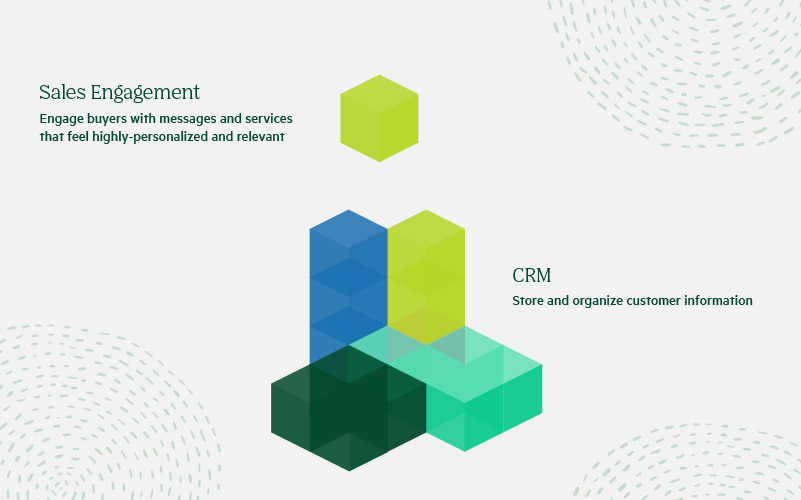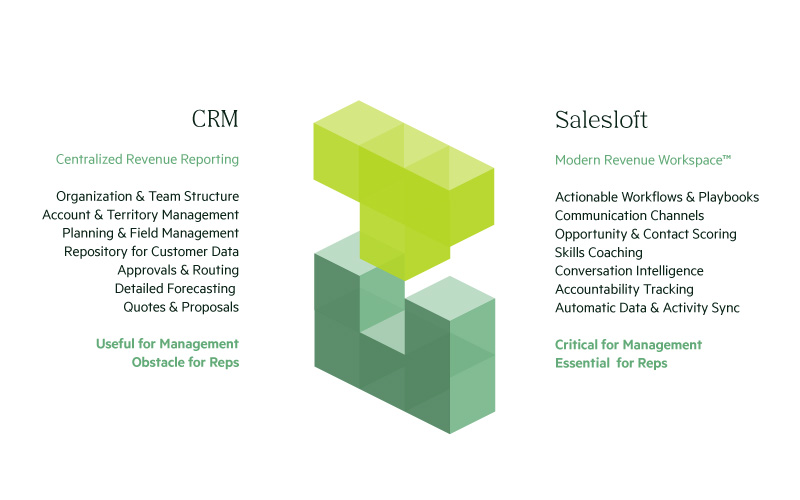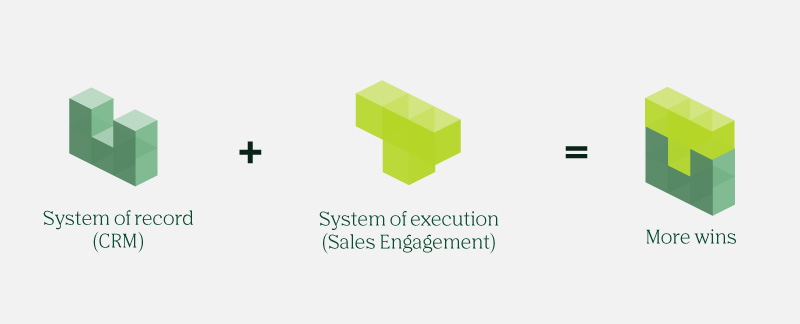Sales Engagement Platform VS. CRM: Why You Need Both
Updated:
Published:

For productivity and profitability, your sellers need the ability to work quickly and efficiently. Most sales orgs already use a CRM like Salesforce or HubSpot but realize that this platform alone doesn’t help sellers powerfully connect with prospects and customers.
Luckily, sales engagement platforms do just that—supercharging your revenue efforts by automating repetitive tasks, identifying deal blockers, and making it easy to replicate the most effective selling behaviors. See Salesloft in action.
This post will show you how sales engagement fills the gaps your CRM leaves and how using the two together accelerates deal velocity.
The Difference Between Your CRM And A Sales Engagement Platform
As two of the most critical pillars of the tech stack, sales engagement and CRM are often thought of interchangeably, but this isn’t the case. Instead, you should be integrating both of these tools to optimize sales activities.
Here’s any easy way to think about it: your CRM stores and organizes your customer contact information and records the interactions. Then, your sales engagement platform uses automation to create hyper-personalized interactions with buyers without sacrificing scale.

Whereas salespeople often have to retroactively update their CRM to log their activities (usually after some nagging), sales engagement gives sellers one unified platform to start and end their day in, automatically logging each selling activity.
The top sales engagement platforms leverage AI and machine learning to not only automate selling activities but also identify what’s working, so sellers are always making strategic, data-backed decisions.
For example, instead of starting a prospecting email from scratch and crossing their fingers in hopes of a response, sales engagement allows you to send the messaging sequence with the highest positive response rate.
CRM: Your System of Record
CRMs store and analyze customer insights to grow relationships.
Think of your CRM as your customer database. Customer records are collected and updated throughout the customer life cycle, making your CRM a central archive for vital data. Your company can use this information to enhance customer relationships, boost customer retention, and improve sales performance.
A CRM provides your organization with the following benefits:
- Syncs all customer and prospect contact information. A CRM is like a smart, connected Rolodex, storing all emails and contacts. Contacts are automatically sync on a central dashboard so the entire organization can easily access them.
- Organizes tasks to create a seamless customer experience. Using your CRM, your team can schedule and assign tasks to different departments across the company. These tasks usually center around customers and prospects, reminding your team to offer service, sales, and marketing at the right time.
- Creates reports that direct and shape revenue strategy. Your CRM analyzes sales data so you can create reports that can help you develop an effective strategy for providing a better customer experience and increasing customer loyalty.

Sales engagement: Your System of Action
Sales engagement platforms automate sales interactions enhancing communication with buyers.
Sure—your CRM probably is logging some sales activities, but sales engagement provides a much more comprehensive view into deals. Sales engagement platforms auto-log and analyze each touchpoint throughout the customer lifecycle, so you get a complete picture of what it takes for your sales team to hit quota.
With this information, you can educate your team on the best communication channels, optimal times to reach out, and the most compelling scripts and cadences. Data and reporting help leaders eliminate guesswork and build strategies based on facts—not guesses. The outcome? An accelerated sales cycle and increased revenue.
Implementing Sales engagement provides your organization with the following benefits:
- Increases response and open rates with call and email connection stats
Sellers can work smarter and not harder by reaching out to prospects and customers at the times they’re most likely to respond. Is there anything more motivating for sellers than higher response rates and booked meetings?
- Identifies top-performing sales strategies so you can repeat them
What are your top performers doing and saying? With sales engagement, you can easily identify what’s working so the rest of the team can follow suit. It also allows you to standardize on your most effective email templates and call scripts so new reps can ramp up fast, and existing reps can have more success engaging buyers.
- Provides a clear breakdown of your pipeline so you can create winning strategies
To hit their numbers, every seller needs a clear picture of their pipeline. Unfortunately, getting an accurate pipeline view usually requires a ton of time entering and updating data. With sales engagement, you can finally say goodbye to the hassle since sellers can log tasks from wherever they’re working, updating your CRM automatically.
How Sales Engagement Increases Your Win Rates
The benefits of sales engagement go beyond the rep level. With sales engagement, you’ll see team productivity and engagement wins across the board.
Here are some benefits that each role will experience with sales engagement:
- Sales Managers: Your sales engagement platform records, transcribes, and annotates all calls and meetings, storing best practices in a library so you can replicate your top-performers. You can finally feel confident you’re making smart decisions and creating effective strategies that result in more wins for your team.
- Front-line Sellers (SDRs, BDRs, etc.): Personalize communication at scale to cut through the noise of increasingly complex sales cycles. Automated message cadences allow reps to conquer buyer communication despite the increasing number of buyer interactions needed to close deals.
- Account Executives (AEs): Provide an unrivaled customer experience so you can upsell and renew your customers. Using data from your past activities, sales engagement recommends the best content and next steps to provide the service your customers have come to expect.
- Sales Operations (or Rev Ops): Gather and analyze next-level KPIs for a more accurate view of revenue team performance. Keep your team aligned by easily prioritizing requests from cross-functional teams一all within one unified platform.
- Inbound SDRs and Marketing: Generate more leads despite decreasing marketing budgets! Sales engagement allows marketing to hand over the right leads to the right sellers at the right time一while ensuring that those sellers are using consistent messaging to deliver a unified experience.
Integrating your CRM And Sales Engagement Platform for Predictable Revenue Growth

Your sales engagement platform and your CRM are two of the most fundamental pieces of your tech stack, so it only makes sense to integrate them for the best results.
To ensure you choose a sales engagement platform that powerfully complements your CRM,
- Involve your CRM support early.
Let your CRM administrator know you’re evaluating sales engagement solutions and ask them for a list of integration requirements and specs. The decision process will be more successful if your admin is looped in earlier rather than later.
- List out your current tech stack for easy evaluation.
Make a list of your existing sales technology vendors. This list will help you figure out which tools you can get rid of, and which ones you’ll keep to integrate with your sales engagement platform.
- Define sales process steps to flow into your sales engagement platform.
Start planning workflows from your CRM and other apps with the intention that all data will flow into your sales engagement platform, which will provide you with more granular analytics.
- Share your tech stack list with prospective sales engagement providers.
Be sure to share your tech vendor list with your sales engagement provider to determine the level of support they can provide.
These are the benefits you’ll get by connecting your sales engagement platform with your CRM:
- Reducing annoying admin tasks
Did you know that on average, reps are only spending one-third of their day selling? Reduce the administrative burden of re-entering customer data into different systems. Allowing reps to focus revenue-generating activities is crucial to their productivity and success.
- Improving the quality of your data for accurate pipeline and forecasting
Manually entering data into a CRM is a time-consuming, error-prone process. Luckily, sales engagement platforms automatically capture contact, account, opportunity, activity, and buyer engagement data in real-time, syncing it automatically with your other apps and systems. The result? Less costly errors and data latency!
- Maximizing usage (and value!) of your CRM
You became a sales manager to lead and inspire, not nag. With sales engagement, you can stop reminding reps to update the CRM. Sales engagement platforms allow sellers to view, update, and create new CRM records right from their inboxes!
The Bottom Line: Sales Engagement Platforms and CRM Team Up To Boost Revenue
While your CRM and sales engagement platform will feed off of each other throughout your sales process, do not confuse these two tools as one and the same. With your sales engagement platform working hand in hand with your CRM, you’ll see gains in deal velocity, customer retention, and revenue.
By gathering critical insights from your sales process, sales engagement maximizes CRM data to ensure your strategies and decisions are fact-based and effective. Keep your sales reps focused by providing them with an all-in-one workspace they can use for every selling activity. With sales engagement you can finally ditch the CRM drama so sellers can focus on what they were hired to do: close deals.





























